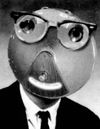toaster3000 wrote:that is clever... i am going to be the asshole who asks 'what's so hard about just recording to tape?' you've done this well, and i'm glad it works for you, but if i want to use tape, it is so much easier to just track to tape, get the take, do some overdubs, and then dump later (if at all!!! ) for overdubs beyond the analog track count...
i suppose this is a really great solution for someone like yourself, however, with only 10 tracks total of tape (AWESOME MCI 1"8tk, by the way...) to get analog sounds on every single track, but for someone with a 16 or 24 tk, i feel like setting all this software routing and monitoring and not knowing what the sound is actually like coming off tape, is too much hassle for me.
i totally commend you for your success and obvious hard work, but it still seems kinda wierd to me... i don't want to have to keep rewinding tape all the time, if i still have to stare at a stupid computer screen... the freedom of analog, in terms of having to use your ears and not having to stare at a screen and use a mouse, seems to be lost, to me.
anyway, not trying to be grumpy about your cool discovery, i guess i am just someone who 'doesn't get it' in terms of what is so inconvenient about using a tape machine in the traditional sense, and then transferring when the time comes... but then, i like to stay analog as long as possible, so my personal recording approach is philosophically at odds with this technique... soooo... what am i talking about?
great job, and good video!
grumpy purist,
john
Hey John,
I realize that some purists out there are really tied to their tried and true old school methods of recording to tape. And that's totally cool. I'm not trying to persuade anyone to come over to the dark side of ITB recording. What I'm proposing is a solution for those of us that want the tape sound, but want to work in a non-linear digital realm while enjoying all the conveniences of precise punch-ins, cycle recording, zero rewinding between takes, retrospective record, unlimited multiple takes, etc.
Let me clarify a little bit as I respond to your points. I know there are probably others reading this wondering the same thing.
If I wanted to track to tape and overdub old school I would need, an analog console, performers that can play well, multiple reels of tape for multiple takes, and time to rewind and locate punch in points for overdubs. When you typically record using a computer you don't need any of those (sad to say regarding the performers). With the system I've worked out, you can record to the computer as many of us are used to, while having some or all of your tracks hit as many different tape decks and tape formulations as you would like. And you don't have to rewind, change reels, or be limited by the amount of tape you have on hand. I've personally been using the same couple reels of tape since this past winter.
Regarding rewinding the tape....you can totally leave the tape running even if you are not recording on the computer or if you are playing back from the computer. The only time you must stop and rewind your tape deck is when you are at the end of the reel. So that occurs every 30 minutes for me running at 15 ips. So in that 30 minutes I could track a song, do a bunch of overdubs, load up a template for new song and do another couple takes. If I was tracking all that in an old-school analog fashion I probably would have already rewound the tape a number of times and/or switched out reels.
Basically this allows you to offer your clients, your band, or yourself the best sound possible (analog tape) while recording using modern ITB approaches. If you make records best while working 100% OTB with a console and tape deck then you have my utmost respect and envy.

Thanks for the feedback and the compliments.
Brad


